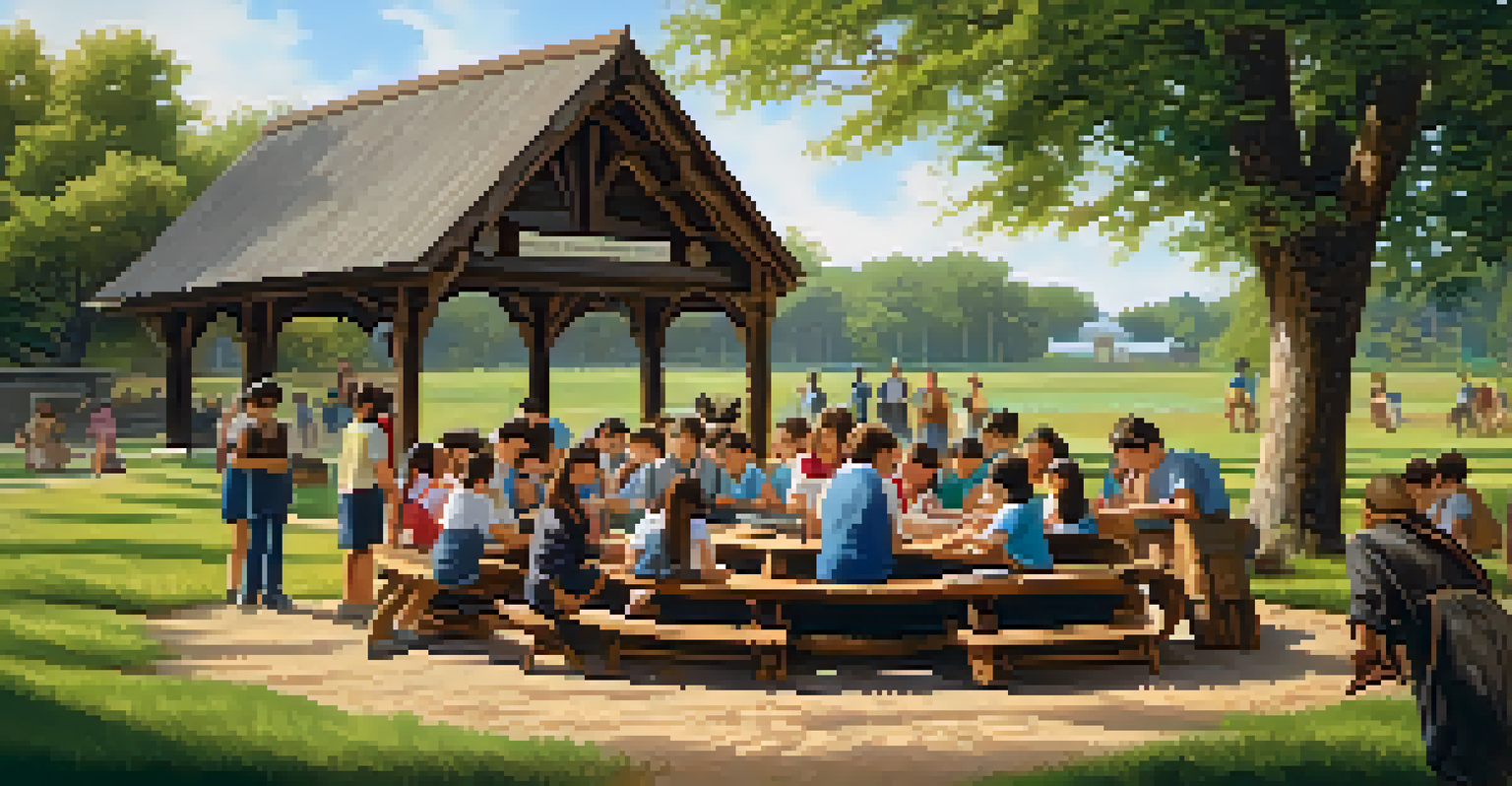Heritage Parks: A Journey Through America's Past

What Are Heritage Parks and Their Purpose?
Heritage parks are special places that preserve and celebrate the history and culture of a region. They often showcase significant historical events, landmarks, and traditions that have shaped the area. These parks serve as educational resources, encouraging visitors to explore and understand the past in a meaningful way.
History is not a burden on the memory but an illumination of the soul.
Imagine walking through a heritage park and encountering reenactments, historical artifacts, or guided tours that transport you back in time. This immersive experience not only brings history to life but also fosters a sense of connection to our collective heritage. By understanding where we came from, we can better appreciate the present.
Moreover, heritage parks promote community engagement and pride. They often host events, workshops, and festivals that allow locals and visitors alike to participate in cultural celebrations. In doing so, they create a vibrant atmosphere that honors traditions while inviting new generations to take part in preserving them.
The Role of Heritage Parks in Education
Heritage parks play a vital role in education by providing hands-on learning experiences. Unlike textbooks, these parks allow students to see, touch, and interact with history, making it come alive in ways that lectures cannot. This experiential learning fosters a deeper understanding and appreciation for historical events and figures.

For instance, many heritage parks offer school programs that include guided tours and interactive activities tailored for students. Imagine children dressing up in period costumes or participating in historical games that give them a taste of life in a different era. These engaging experiences can ignite a passion for history that lasts a lifetime.
Heritage Parks Preserve Culture
Heritage parks play a crucial role in preserving and celebrating the history and culture of a region.
Additionally, heritage parks often collaborate with local schools and organizations to create curriculum-based programs. This partnership helps ensure that educational content is relevant and aligned with state standards, creating a seamless bridge between classroom learning and real-world experiences.
A Closer Look at Notable Heritage Parks
Across the United States, several heritage parks stand out for their unique contributions to preserving history. For example, the Gettysburg National Military Park in Pennsylvania commemorates the pivotal Civil War battle and invites visitors to reflect on its significance. The park features extensive trails, monuments, and visitor centers that enhance the educational experience.
The past is never dead. It's not even past.
Another remarkable site is the San Juan National Historic Site in Puerto Rico, which showcases the island's colonial history through its well-preserved forts and vibrant cultural landscape. Here, visitors can explore centuries-old structures while learning about the rich tapestry of influences that shaped Puerto Rican heritage.
These parks not only attract tourists but also inspire local communities to engage with their history. They serve as reminders of the struggles and triumphs that have defined our nation, encouraging reflection and connection among diverse groups of people.
The Economic Impact of Heritage Parks
Heritage parks also play a significant role in boosting local economies. By attracting tourists, they create jobs and generate revenue for surrounding businesses, from hotels and restaurants to shops and attractions. The influx of visitors can stimulate economic growth, especially in regions that may lack other sources of income.
For example, towns near heritage parks often see an increase in foot traffic during peak tourist seasons. This influx not only benefits local businesses but also encourages investment in infrastructure and services, enhancing the overall quality of life for residents. As communities rally around these parks, they can experience revitalization and development.
Education Through Experiential Learning
These parks provide hands-on learning experiences that engage students and foster a deeper appreciation for history.
Moreover, heritage parks often host events that draw larger crowds, such as festivals, reenactments, and educational workshops. These gatherings not only promote cultural heritage but also provide additional opportunities for local entrepreneurs to showcase their products and services, creating a win-win scenario for the community.
Preserving Nature and History Together
Many heritage parks are located in areas of natural beauty, which adds another layer of significance to their preservation efforts. These parks often encompass historical sites alongside stunning landscapes, creating a unique blend of cultural and natural heritage. This relationship highlights the interconnectedness of our environment and our history.
For instance, the Appalachian Trail, which traverses various heritage parks, allows hikers to experience not only the natural beauty of the mountains but also the rich history tied to the region's cultural development. The trail serves as a living testament to the ways in which nature and history intertwine, inviting exploration and reflection.
By promoting conservation efforts within heritage parks, we ensure that future generations can enjoy both the historical and natural elements that define these spaces. This dual focus on preservation enriches our understanding of the past while fostering respect for the environment.
Challenges Faced by Heritage Parks
Despite their importance, heritage parks face several challenges that can hinder their preservation efforts. Funding is often a significant concern, as many parks rely on government grants and donations to maintain their facilities and programs. Without adequate financial resources, these parks may struggle to offer the quality experiences that visitors expect.
Moreover, changing demographics and interests can impact visitor engagement. As society evolves, the stories and narratives that resonate with people may shift, prompting heritage parks to adapt their programming and outreach efforts. This need for flexibility can be daunting, but it's essential for ensuring continued relevance.
Economic Benefits for Communities
Heritage parks stimulate local economies by attracting tourists, creating jobs, and encouraging community engagement.
Finally, environmental factors such as climate change pose additional threats to heritage parks. Rising sea levels, extreme weather events, and changing ecosystems can all affect the preservation of historical sites. It's crucial for park management to develop strategies to mitigate these risks, ensuring that the rich stories of our past remain accessible for future generations.
The Future of Heritage Parks
Looking ahead, the future of heritage parks is filled with potential for innovation and growth. With advancements in technology, virtual reality experiences and interactive exhibits can enhance visitor engagement, making history more accessible than ever. Imagine stepping into a digital reenactment of a historical event right from your smartphone or VR headset!
Moreover, increased awareness and appreciation for cultural heritage can lead to greater support for these parks. As communities recognize the value of preserving their history, they may rally together to advocate for funding and resources. This grassroots movement can play a pivotal role in the sustainability of heritage parks.

Ultimately, the future of heritage parks hinges on collaboration. By partnering with local governments, educational institutions, and community organizations, these parks can thrive and continue to educate and inspire generations to come. Together, we can ensure that the lessons of our past remain relevant and that our cultural heritage is celebrated.